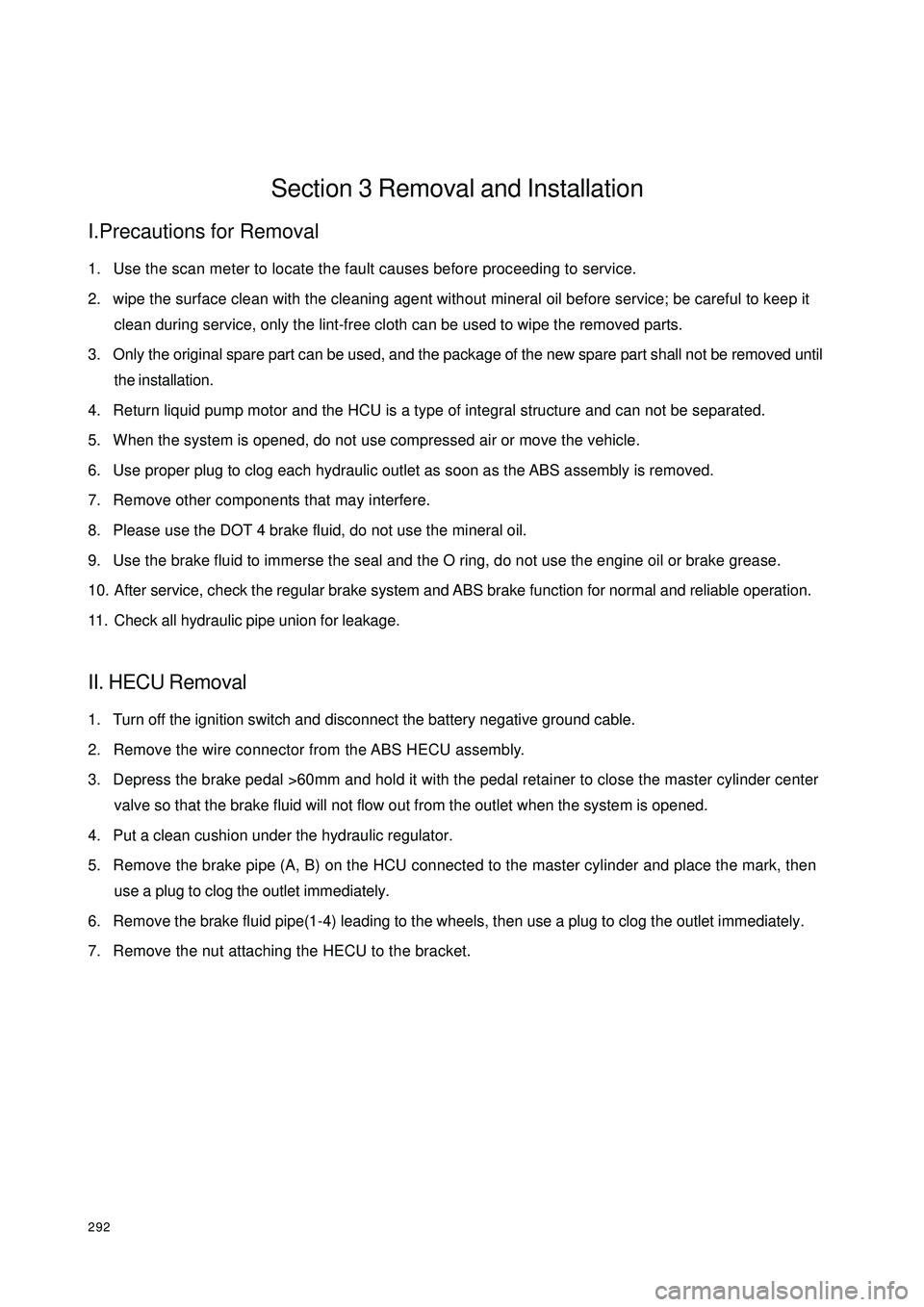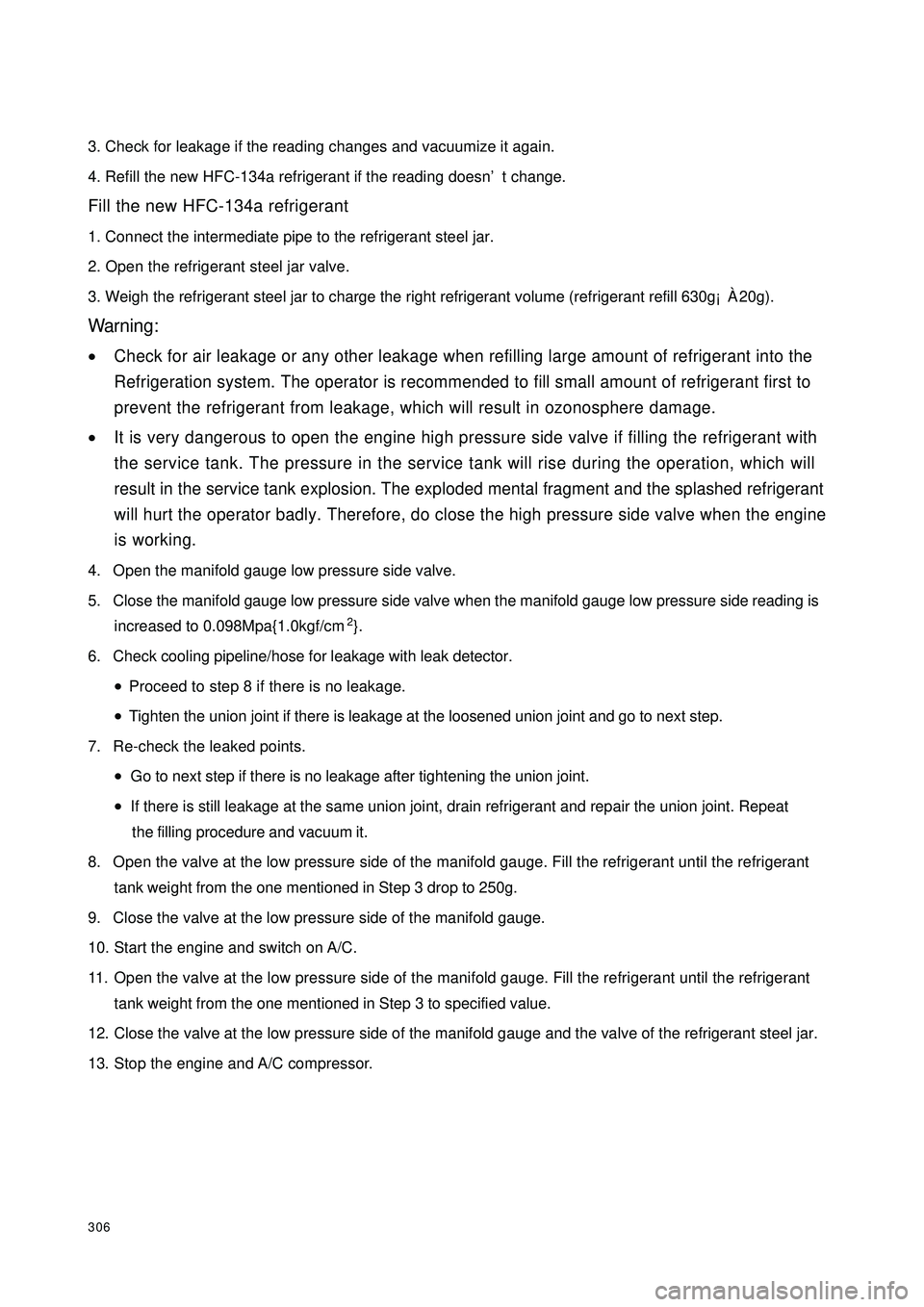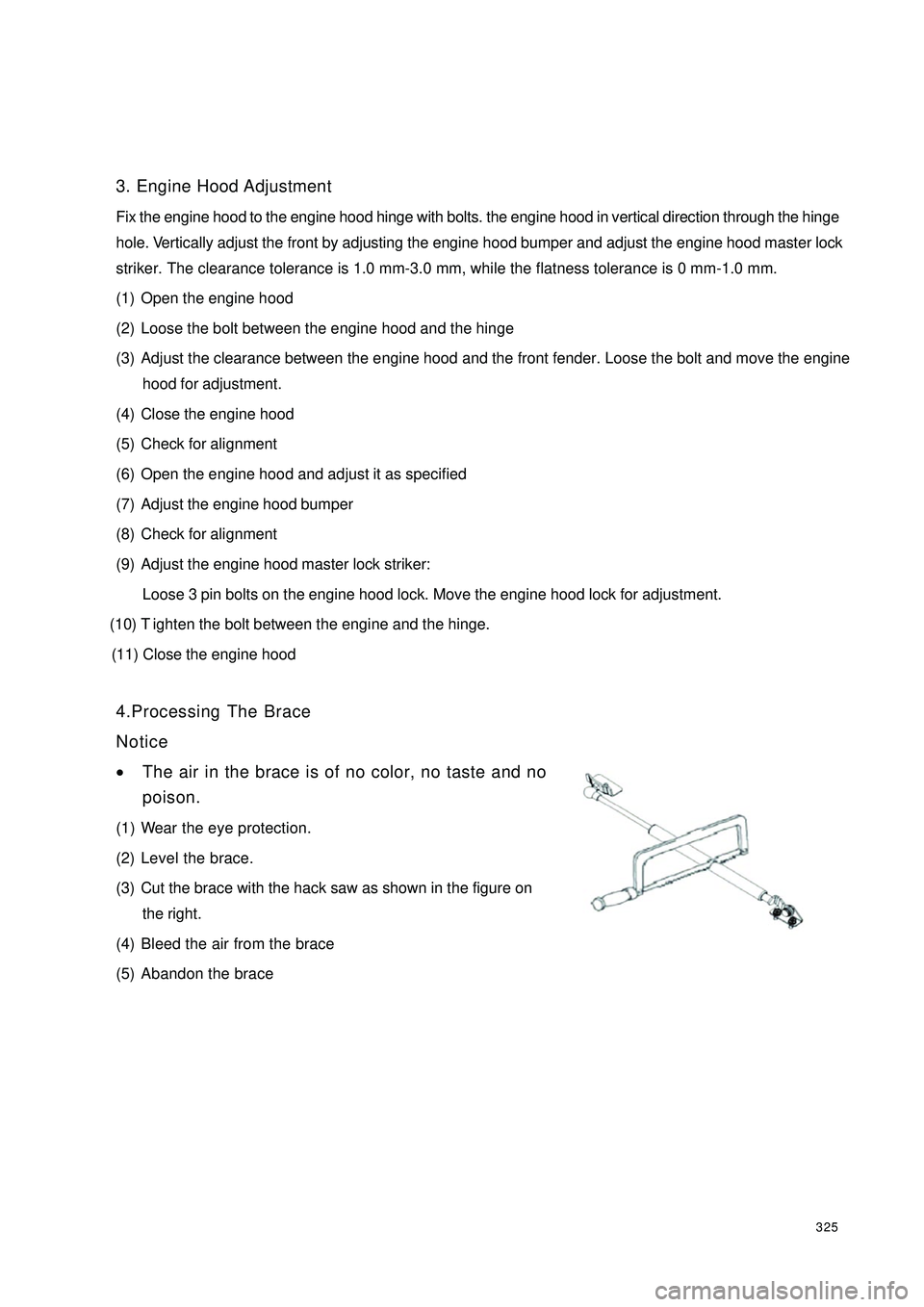check engine GEELY CK 2008 Repair Manual
[x] Cancel search | Manufacturer: GEELY, Model Year: 2008, Model line: CK, Model: GEELY CK 2008Pages: 392, PDF Size: 38.86 MB
Page 299 of 392

292Section 3 Removal and InstallationI.Precautions for Removal1. Use the scan meter to locate the fault causes before proceeding to service.
2. wipe the surface clean with the cleaning agent without mineral oil before service; be careful to keep it
clean during service, only the lint-free cloth can be used to wipe the removed parts.
3. Only the original spare part can be used, and the package of the new spare part shall not be removed until
the installation.
4. Return liquid pump motor and the HCU is a type of integral structure and can not be separated.
5. When the system is opened, do not use compressed air or move the vehicle.
6. Use proper plug to clog each hydraulic outlet as soon as the ABS assembly is removed.
7. Remove other components that may interfere.
8. Please use the DOT 4 brake fluid, do not use the mineral oil.
9. Use the brake fluid to immerse the seal and the O ring, do not use the engine oil or brake grease.
10. After service, check the regular brake system and ABS brake function for normal and reliable operation.
11. Check all hydraulic pipe union for leakage.II. HECU Removal1. Turn off the ignition switch and disconnect the battery negative ground cable.
2. Remove the wire connector from the ABS HECU assembly.
3. Depress the brake pedal >60mm and hold it with the pedal retainer to close the master cylinder center
valve so that the brake fluid will not flow out from the outlet when the system is opened.
4. Put a clean cushion under the hydraulic regulator.
5. Remove the brake pipe (A, B) on the HCU connected to the master cylinder and place the mark, then
use a plug to clog the outlet immediately.
6. Remove the brake fluid pipe(1-4) leading to the wheels, then use a plug to clog the outlet immediately.
7. Remove the nut attaching the HECU to the bracket.
Page 313 of 392

3063. Check for leakage if the reading changes and vacuumize it again.
4. Refill the new HFC-134a refrigerant if the reading doesn’t change.
Fill the new HFC-134a refrigerant
1. Connect the intermediate pipe to the refrigerant steel jar.
2. Open the refrigerant steel jar valve.
3. Weigh the refrigerant steel jar to charge the right refrigerant volume (refrigerant refill 630g¡À20g).Warning:•Check for air leakage or any other leakage when refilling large amount of refrigerant into the
Refrigeration system. The operator is recommended to fill small amount of refrigerant first to
prevent the refrigerant from leakage, which will result in ozonosphere damage.•It is very dangerous to open the engine high pressure side valve if filling the refrigerant with
the service tank. The pressure in the service tank will rise during the operation, which will
result in the service tank explosion. The exploded mental fragment and the splashed refrigerant
will hurt the operator badly. Therefore, do close the high pressure side valve when the engine
is working.4. Open the manifold gauge low pressure side valve.
5. Close the manifold gauge low pressure side valve when the manifold gauge low pressure side reading is
increased to 0.098Mpa{1.0kgf/cm2}.
6. Check cooling pipeline/hose for leakage with leak detector.
•Proceed to step 8 if there is no leakage.
•Tighten the union joint if there is leakage at the loosened union joint and go to next step.
7. Re-check the leaked points.
•Go to next step if there is no leakage after tightening the union joint.
•If there is still leakage at the same union joint, drain refrigerant and repair the union joint. Repeat
the filling procedure and vacuum it.
8. Open the valve at the low pressure side of the manifold gauge. Fill the refrigerant until the refrigerant
tank weight from the one mentioned in Step 3 drop to 250g.
9. Close the valve at the low pressure side of the manifold gauge.
10. Start the engine and switch on A/C.
11. Open the valve at the low pressure side of the manifold gauge. Fill the refrigerant until the refrigerant
tank weight from the one mentioned in Step 3 to specified value.
12. Close the valve at the low pressure side of the manifold gauge and the valve of the refrigerant steel jar.
13. Stop the engine and A/C compressor.
Page 314 of 392

307Check For Leakage:
1. Using leak detector, check refrigerant steel jar for leakage.
•Go to Step 3 if there is no leakage.
•Tighten the union joint if there is leakage at the loosened union joint and go to next step.
2. Re-check the leaked points.
•Go to next step if there is no leakage after tightening the union joint.
•If there is still leakage at the same union joint, drain refrigerant and vacuum the union joint.
3. Disconnect the high and low pressure pipe at the refill valve.
4. Install the filling valve cap.
Check Refrigerant Pressure:
1. Install the manifold gauge.
2. Warm up the engine and run it with constant 1800rpm.
3. Set the rpm of the cooling fan to the HIGHEST.
4. Turn on the A/C switch.
5. Set to internal circulation mode.
6. Set the temperature control mode to the COLDEST.
7. Set to be ventilation mode.
8. Close all door and windows.
9. Measure the environment temperature and the reading of the high pressure side and low pressure side
from the manifold gauge.
•Shoot the Refrigeration system trouble as required if it is not as specified in the technical specification.
The Performance Inspection of the Refrigeration System:
1. Check refrigerant pressure.
•Go to next step if the pressure value is correct.
•Shoot the Refrigeration system trouble promptly if the pressure value is not as specified in the
technical specification.
2. Insert a thermometer into the middle vent port at the driver's side.
3. Warm up the engine and run it at the constant 1800rpm.
4. Set the rpm of the cooling fan to the HIGHEST.
5. Switch on A/C.
6. Set to internal circulation mode.
7. Set the temperature control mode to the COLDEST.
8. Set to Ventilation Mode.
9. Close all doors and windows.
10. Wait until A/C output temperature is constant. (When the environment temperature is 38°C, the temperature
at the middle ventilation port at the drivers side is 10°C~16°C. )
Page 317 of 392

3104. A/C Compressor Removal / Installation1. Disconnect the negative (--) terminal cable from the battery.
2. Drain the refrigerant from the system.
3. Detach the radiator.
4. Loose the drive belt and then remove the drive belt.Notice:•If anything moisture or any foreign matter enters into the Refrigeration system for circulation,
the cooling performance of the Refrigeration system will obviously deteriorate with abnormal
noise. Plug the port immediately after removing any cooling circulation component to prevent
anything moistur or any foreign matter from entering the circulation.5. Remove the compressor inlet and outlet pipe.
6. Removemagnetic clutch connector.
7. Remove the compressor.
8. The installation is in the reverse order of the removal.
9. Adjust the drive belt.
10. Check the Refrigeration system performance.5. The Condenser Removal / Installation1. Disconnect the negative (--) terminal cable from the battery.
2. Drain the refrigerant from the system.Notice:•If anything moisture or any foreign matter enters into the Refrigeration system for circulation,
the cooling performance of the Refrigeration system will obviously deteriorate with abnormal
noise. Plug the port immediately after removing any cooling circulation component to prevent
anything moistur or any foreign matter from entering the circulation.3. Remove the condenser inlet and outlet pipeline to prevent the compressor oil from splashing.
4. Remove condenser fan connector.
5. Remove the engine hood lock.
6. Remove the engine hood lock support brace.
7. Remove the condenser.
8. The installation is in the reverse order of the removal.
9. Check the Refrigeration system performance.The Condenser Installation Description:1. When installing the new condenser, it is recommended to fill certain SW-100 compressor oil into the
refrigerant circuit.Refill: (approximate)
20ml{20 cc }
Page 332 of 392

3253. Engine Hood Adjustment
Fix the engine hood to the engine hood hinge with bolts. the engine hood in vertical direction through the hinge
hole. Vertically adjust the front by adjusting the engine hood bumper and adjust the engine hood master lock
striker. The clearance tolerance is 1.0 mm-3.0 mm, while the flatness tolerance is 0 mm-1.0 mm.
(1) Open the engine hood
(2) Loose the bolt between the engine hood and the hinge
(3) Adjust the clearance between the engine hood and the front fender. Loose the bolt and move the engine
hood for adjustment.
(4) Close the engine hood
(5) Check for alignment
(6) Open the engine hood and adjust it as specified
(7) Adjust the engine hood bumper
(8) Check for alignment
(9) Adjust the engine hood master lock striker:
Loose 3 pin bolts on the engine hood lock. Move the engine hood lock for adjustment.
(10) Tighten the bolt between the engine and the hinge.
(11) Close the engine hood
4.Processing The Brace
Notice
•The air in the brace is of no color, no taste and no
poison.
(1) Wear the eye protection.
(2) Level the brace.
(3) Cut the brace with the hack saw as shown in the figure on
the right.
(4) Bleed the air from the brace
(5) Abandon the brace